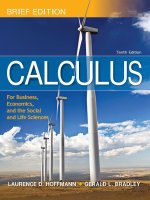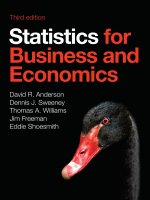Statistics for business economics 7th by paul newbold chapter 17
Bạn đang xem bản rút gọn của tài liệu. Xem và tải ngay bản đầy đủ của tài liệu tại đây (159.87 KB, 27 trang )
Statistics for
Business and Economics
7th Edition
Chapter 17
Additional Topics in Sampling
Copyright © 2010 Pearson Education, Inc. Publishing as Prentice Hall
Ch. 17-1
Chapter Goals
After completing this chapter, you should be
able to:
Explain the difference between simple random sampling
and stratified sampling
Analyze results from stratified samples
Determine sample size when estimating population
mean, population total, or population proportion
Describe other sampling methods
Cluster Sampling, Two-Phase Sampling, Nonprobability Samples
Copyright © 2010 Pearson Education, Inc. Publishing as Prentice Hall
Ch. 17-2
Types of Samples
(continued)
Samples
Probability Samples
Simple
Random
Cluster
(Chapter 6)
Non-Probability
Samples
Quota
Convenience
Stratified
Copyright © 2010 Pearson Education, Inc. Publishing as Prentice Hall
Ch. 17-3
17.1
Stratified Sampling
Overview of stratified sampling:
Divide population into two or more subgroups (called
strata) according to some common characteristic
A simple random sample is selected from each subgroup
Samples from subgroups are combined into one
Population
Divided
into 4
strata
Sample
Copyright © 2010 Pearson Education, Inc. Publishing as Prentice Hall
Ch. 17-4
Stratified Random Sampling
Suppose that a population of N individuals can be
subdivided into K mutually exclusive and collectively
exhaustive groups, or strata
Stratified random sampling is the selection of
independent simple random samples from each
stratum of the population.
Let the K strata in the population contain N1, N2,. . .,
NK members, so that N1 + N2 + . . . + NK = N
Let the numbers in the samples be n1, n2, . . ., nK.
Then the total number of sample members is
n1 + n 2 + . . . + n K = n
Copyright © 2010 Pearson Education, Inc. Publishing as Prentice Hall
Ch. 17-5
Estimation of the Population Mean,
Stratified Random Sample
Let random samples of nj individuals be taken from
strata containing Nj individuals (j = 1, 2, . . ., K)
Let
K
K
Nj N and n j n
j1
j1
Denote the sample means and variances in the strata
by Xj and sj2 and the overall population mean by μ
An unbiased estimator of the overall population mean
μ is:
K
1
x st N j x j
N j1
Copyright © 2010 Pearson Education, Inc. Publishing as Prentice Hall
Ch. 17-6
Estimation of the Population Mean,
Stratified Random Sample
(continued)
An unbiased estimator for the variance of the overall population
mean is
σˆ 2xst
1
2
N
where
σˆ 2x j
K
2 2
N
j σˆ x j
j 1
s2j
(N j n j )
nj
Nj 1
Provided the sample size is large, a 100(1 - )% confidence
interval for the population mean for stratified random samples is
x st z α/2σˆ x st μ x st z α/2σˆ x st
Copyright © 2010 Pearson Education, Inc. Publishing as Prentice Hall
Ch. 17-7
Estimation of the Population Total,
Stratified Random Sample
Suppose that random samples of nj individuals from
strata containing Nj individuals (j = 1, 2, . . ., K) are
selected and that the quantity to be estimated is the
population total, Nμ
An unbiased estimation procedure for the population
total Nμ yields the point estimate
K
Nx st N j x j
j1
Copyright © 2010 Pearson Education, Inc. Publishing as Prentice Hall
Ch. 17-8
Estimation of the Population Total,
Stratified Random Sample
(continued)
An unbiased estimation procedure for the variance of
the estimator of the population total yields the point
estimate
K
N2σˆ 2xst N2jσˆ 2xst
j 1
Provided the sample size is large, 100(1 - )%
confidence intervals for the population total for
stratified random samples are obtained from
Nx st z α/2Nσˆ st Nμ Nx st z α/2Nσˆ st
Copyright © 2010 Pearson Education, Inc. Publishing as Prentice Hall
Ch. 17-9
Estimation of the Population
Proportion, Stratified Random Sample
Suppose that random samples of nj individuals from
strata containing Nj individuals (j = 1, 2, . . ., K) are
obtained
Let Pj be the population proportion, and pˆ j the
sample proportion, in the jth stratum
If P is the overall population proportion, an unbiased
estimation procedure for P yields
K
1
pˆ st N jpˆ j
N j1
Copyright © 2010 Pearson Education, Inc. Publishing as Prentice Hall
Ch. 17-10
Estimation of the Population
Proportion, Stratified Random Sample
(continued)
•
An unbiased estimation procedure for the
variance of the estimator of the overall population
proportion is
σˆ p2ˆ st
where
1
2
N
K
2 2
N
j σˆ pˆ j
j 1
pˆ j (1 pˆ j ) (Nj n j )
σˆ
nj 1
Nj 1
2
pˆ j
is the estimate of the variance of the sample proportion in
the jth stratum
Copyright © 2010 Pearson Education, Inc. Publishing as Prentice Hall
Ch. 17-11
Estimation of the Population
Proportion, Stratified Random Sample
(continued)
Provided the sample size is large, 100(1 - )%
confidence intervals for the population proportion for
stratified random samples are obtained from
pˆ st z α/2σˆ pˆ st P pˆ st z α/2σˆ pˆ st
Copyright © 2010 Pearson Education, Inc. Publishing as Prentice Hall
Ch. 17-12
Proportional Allocation:
Sample Size
One way to allocate sampling effort is to make the
proportion of sample members in any stratum the same
as the proportion of population members in the stratum
If so, for the jth stratum,
nj
n
Nj
N
The sample size for the jth stratum using proportional
allocation is
nj
Copyright © 2010 Pearson Education, Inc. Publishing as Prentice Hall
Nj
N
n
Ch. 17-13
Optimal Allocation
To estimate an overall population mean or total and if the
population variances in the individual strata are
denoted σj2 , the most precise estimators are obtained
with optimal allocation
The sample size for the jth stratum using optimal
allocation is
nj
N jσ j
n
K
Nσ
i
i
i1
Copyright © 2010 Pearson Education, Inc. Publishing as Prentice Hall
Ch. 17-14
Optimal Allocation
(continued)
To estimate the overall population proportion, estimators
with the smallest possible variance are obtained by
optimal allocation
The sample size for the jth stratum for population
proportion using optimal allocation is
nj
N j Pj (1 Pj )
K
N
i
n
Pi (1 Pi )
i1
Copyright © 2010 Pearson Education, Inc. Publishing as Prentice Hall
Ch. 17-15
Determining Sample Size
The sample size is directly related to the size
of the variance of the population estimator
If the researcher sets the allowable size of
the variance in advance, the necessary
sample size can be determined
Copyright © 2010 Pearson Education, Inc. Publishing as Prentice Hall
Ch. 17-16
Sample Size for Stratified
Random Sampling: Mean
Suppose that a population of N members is subdivided
in K strata containing N1, N2, . . .,NK members
Let σj2 denote the population variance in the jth stratum
An estimate of the overall population mean is desired
2
σ
If the desired variance, x st , of the sample estimator is
specified, the required total sample size, n, can be
found
Copyright © 2010 Pearson Education, Inc. Publishing as Prentice Hall
Ch. 17-17
Sample Size for Stratified
Random Sampling: Mean
(continued)
For proportional allocation:
K
2
N
σ
j j
j1
n
Nσ
2
x st
1 K
N jσ 2j
N j1
For optimal allocation:
1 K
2
N jσ j
N j1
n
1 K
2
Nσ x st N jσ 2j
N j1
Copyright © 2010 Pearson Education, Inc. Publishing as Prentice Hall
Ch. 17-18
17.2
Cluster Sampling
Population is divided into several “clusters,”
each representative of the population
A simple random sample of clusters is selected
Generally, all items in the selected clusters are examined
An alternative is to chose items from selected clusters using
another probability sampling technique
Population
divided into
16 clusters.
Copyright © 2010 Pearson Education, Inc. Publishing as Prentice Hall
Randomly selected
clusters for sample
Ch. 17-19
Estimators for Cluster Sampling
A population is subdivided into M clusters and a simple
random sample of m of these clusters is selected and
information is obtained from every member of the
sampled clusters
Let n1, n2, . . ., nm denote the numbers of members in
the m sampled clusters
Denote the means of these clusters by x1, x 2 , , x m
Denote the proportions of cluster members possessing
an attribute of interest by P1, P2, . . . , Pm
Copyright © 2010 Pearson Education, Inc. Publishing as Prentice Hall
Ch. 17-20
Estimators for Cluster Sampling
(continued)
The objective is to estimate the overall population mean
µ and proportion P
Unbiased estimation procedures give
Mean
Proportion
m
n x
i
m
i
x c i1m
n
i
i 1
Copyright © 2010 Pearson Education, Inc. Publishing as Prentice Hall
np
pˆ c i1m
i i
n
i
i1
Ch. 17-21
Estimators for Cluster Sampling
(continued)
Estimates of the variance of these estimators, following from
unbiased estimation procedures, are
Mean
σˆ 2xc
Proportion
m 2
ni (x i x c )2
M m i1
Mm n 2
m 1
σˆ p2ˆ c
m 2
ni (Pi pˆ c )2
M m i1
Mm n 2
m 1
m
Where n
n
i1
m
i
is the average number of individuals in the sampled clusters
Copyright © 2010 Pearson Education, Inc. Publishing as Prentice Hall
Ch. 17-22
Estimators for Cluster Sampling
(continued)
Provided the sample size is large, 100(1 - )%
confidence intervals using cluster sampling are
for the population mean
x c z α/2σˆ x c μ x c z α/2σˆ xc
for the population proportion
pˆ c z α/2σˆ pˆ c P pˆ c z α/2σˆ pˆ c
Copyright © 2010 Pearson Education, Inc. Publishing as Prentice Hall
Ch. 17-23
Two-Phase Sampling
Sometimes sampling is done in two steps
An initial pilot sample can be done
Disadvantage:
takes more time
Advantages:
Can adjust survey questions if problems are noted
Additional questions may be identified
Initial estimates of response rate or population
parameters can be obtained
Copyright © 2010 Pearson Education, Inc. Publishing as Prentice Hall
Ch. 17-24
Other Sampling Methods
(continued)
Samples
Probability Samples
Simple
Random
Cluster
(Chapter 6)
Non-Probability
Samples
Quota
Convenience
Stratified
Copyright © 2010 Pearson Education, Inc. Publishing as Prentice Hall
Ch. 17-25









